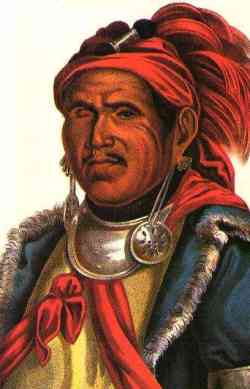Tenskwatawa |
|
|---|---|
| Born | 1775 in Unknown |
| Died | 11/5/1836 in Kansas City, Kansas |
Biography |
|
BiographyBecause his father died before he was born and because his mother left his family shortly after, Lalawethika grew up without parents. Lalawethika was then at the mercy of his siblings to teach him the Shawnee ways. Because he was not close with his older sister or older brother, he never learned how to successfully hunt or to be a good warrior, which are essential roles for a Shawnee man. He accidentally lost an eye in a hunting accident. His poor looks and braggart personality also did not win him many friends. As a result, Lalawethika grew up to be the laughing-stock of his community and he turned to alcohol. Based on Lalawethika's development, it seemed that Lalawethika would never make a contribution to his tribe. However, that changed when Lalawethika was put in trance by the Master of Life. In May 1805, he experienced the first of several visions. He had a taste for whiskey, and in one of his alcoholic stupors he had a vision. After he awoke he began preaching and became a religious leader, and taught that the white Americans were children of the Great Serpent, the source of evil in the world. He also conducted witch hunts against Christian Indians. He forbade his people to use European foods, clothing, manufactured goods and alcohol. He changed his name to Tenskwatawa (The Open Door or One With Open Mouth). In 1808 Tenskwatawa and Tecumseh moved their followers to a new village called Prophetstown (Tippecanoe), near the present-day town of Battle Ground, near the juncture of the Wabash and Tippecanoe rivers in Indiana. Tecumseh's WarThere is some disagreement among historians over whether Tecumseh or Tenskwatawa was really the primary leader of the Pan-Indian community that grew up around Prophetstown. Either way, Tenskwatawa's preachings grew more militant and narrowly political from 1808-1811, as more and more young disaffected warriors from nearby tribes joined his movement. By 1811, both white settlers in the region and the U.S. Army had become quite concerned about what was happening at Prophetstown. Late in 1811, Tecumseh journeyed south to meet with representatives of other tribes in hopes of building a larger alliance, leaving Tenskwatawa in command at Prophetstown. According to legend, Tecumseh ordered Tenskwatawa to avoid any confrontation with whites during his absence. However, on November 7, 1811, while Tecumseh was still away, Tenskwatawa saw a vision and told the other Indians to attack the coming white people. The Americans were under the command of future President William Henry Harrison. Tenskwatawa's forces were soundly defeated. (See the Battle of Tippecanoe.) It was a two hour battle that left many Indians dead or wounded. The Indians buried their men in the night, and stripped The Prophet of his powers. The village at Prophetstown was burned down and the defeat put an end to Tecumseh's hope of a broad Native alliance. With his brother, Tenskwatawa participated in the defense of the Canadian colonies during the War of 1812. In 1813 he was present at the Battle of the Thames, but fled with the British forces and was absent when Tecumseh was killed. Later years and deathIn the following decade he unsuccessfully tried to regain a position of leadership among Native Americans. In 1825 he returned to the United States and assisted in removing many of the Shawnees west of the Mississippi. In 1826 he established a village at the site of modern Kansas City, Kansas. He died in 1836 at his village in Kansas City, Kansas (located in the Argentine area; the White Feather Spring marker notes the location). |
|
 Tenskwatawa, (also called Tenskatawa, Tenskwatawah, Tensquatawa or Lalawethika) (1775 – November 1836) was a Native American religious and political leader of the Shawnee tribe, known as The Prophet or the Shawnee Prophet. He was the brother of Tecumseh, leader of the Shawnee. He was originally given the name Lalawethika (He Makes a Loud Noise or The Noise Maker). He fathered a total of 20 children and had 3 wives.
Tenskwatawa, (also called Tenskatawa, Tenskwatawah, Tensquatawa or Lalawethika) (1775 – November 1836) was a Native American religious and political leader of the Shawnee tribe, known as The Prophet or the Shawnee Prophet. He was the brother of Tecumseh, leader of the Shawnee. He was originally given the name Lalawethika (He Makes a Loud Noise or The Noise Maker). He fathered a total of 20 children and had 3 wives.